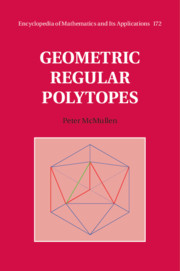Book contents
- Frontmatter
- Contents
- Foreword
- I Regular Polytopes
- II Polytopes of Full Rank
- III Polytopes of Nearly Full Rank
- IV Miscellaneous Polytopes
- 14 Gosset–Elte Polytopes
- 15 Locally Toroidal Polytopes
- 16 A Family of 4-Polytopes
- 17 Two Families of 5-Polytopes
- Afterword
- Bibliography
- Notation Index
- Author Index
- Subject Index
17 - Two Families of 5-Polytopes
from IV - Miscellaneous Polytopes
Published online by Cambridge University Press: 30 January 2020
- Frontmatter
- Contents
- Foreword
- I Regular Polytopes
- II Polytopes of Full Rank
- III Polytopes of Nearly Full Rank
- IV Miscellaneous Polytopes
- 14 Gosset–Elte Polytopes
- 15 Locally Toroidal Polytopes
- 16 A Family of 4-Polytopes
- 17 Two Families of 5-Polytopes
- Afterword
- Bibliography
- Notation Index
- Author Index
- Subject Index
Summary
The final chapter concerns two families of regular 5-polytopes, the second consisting of the double covers of the first. The starting point is a simple group, which is the automorphism group of a regular quotient of a 5-dimensional hyperbolic honeycomb. Armed with only modest information, it is first shown that the realization domain of this polytope is very simple. Two defining relations for the quotient were initially provided; subsequently, it is seen geometrically that one of them is redundant. As in the previous chapter, there is an extended family, among which there are polytopes whose facets and vertex-figures beong to the pentagonal 4-polytopes of Chapter 7 and the family of 4-polytopes described in Chapter 16. The initial quotients are non-orientable; the family of their double covers contains members that are universal as amalgamations. These families of polytopes correspond to actions of the automorphism groups on two of their maximal subgroups. The groups have another maximal subgroup, and though there are no nice related polytopes, nevertheless this gives rise to interesting symmetric sets. There is another quotient and a close relative which one might initially think belong to one of the families; that they do not, with a completely unrelated group, is perhaps surprising.
Keywords
- Type
- Chapter
- Information
- Geometric Regular Polytopes , pp. 546 - 581Publisher: Cambridge University PressPrint publication year: 2020

